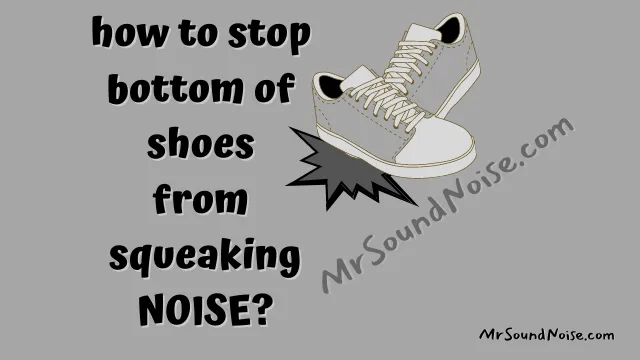
Your noisy shoes may make your life disgusting. When you walk, a squeaky sound comes from your shoe.
You seriously want to know the answer to this question: how to stop your bottom part of shoes from squeaking on hard floors?
Soundproofing the floor surface is another issue, but you should focus on your noisy shoe for reducing sound.
You don’t want bad attention from your office colleague for this unwanted weird noise. You also don’t want to change your current squeaky shoes because you have a budget problem.
When you are in the office, this bad sound may decrease your confidence automatically. Because shoes with design, color, and shape represent the personality of any man and woman. If the sticky noise comes from the shoe or sneaker, then it will be terrible.
What to do now?
You want to stop male, female, and athletic shoes from squeaking. Is there any other solution available for solving this issue?
You may want to know what is the reason for creating this type of irritating noise. Manually (DIY), how to stop the shoes from squeaking when walking on waxed or linoleum floors, and is it possible or not?
In this situation, I want to tell you that you are reading the right blog post for finding the answer and solution to this question.
Here I have shared some techniques to remove that squeaky sound from the casual boots. You need to give time to read this writing with concentration.
I have shared the basic techniques for reducing that sound from common boots. The design of your show may not match this common shoe. But you can apply your selected techniques to your current boot in your way.
So, continue writing…
Reason For Squeaking Your Shoes
Sometimes air gaps or air bubbles may be contained in the area of squeaky soles and insole section. Besides, moisture may also exist in the shoe parts.
When friction is created between your leg and shoe, then it may create a squeaking sound. That air gap or moisture may be created by rubbing the shoe parts.
For uneven wear of the bottom part of the shoe soles, sound may be created. Uneven rubber/leather/Vibram soles may create some squeaky noise when you walk on the finished floor.
Water damage to the insole, the insole of new leather may also create squeaky noise. Leather can easily absorb water and that water damages the insole quickly.
Old boots may also create noise when the parts of the boots are loose. At that time leather parts may create some noise for loose parts (soles and other leather elements).
The main noise comes from the entire synthetic soles and insole area of the dress shoes and other common boots during rubbing. This is why you should fix it properly as early as possible.
How to Stop (Fix) the Shoes From Squeaking on the Hard Floor
Now I will share some methods to reduce squeaky noise from the boot. Maximum time, this sound may be created, when you walk on the smooth floor without a mat.
In that situation, you should know the answer to this question: How to make shoes that don’t squeak on smooth linoleum floors?
Besides, this type of sound may also be created when you go outside. So, you should focus on the methods below urgently.
One: Rubber Sole Spray
If your current shoes have rubber soles and it is also slippery, it creates noise during walking. At this time, to make a little rough of that sole you may use effective Rubber Sole Spray.
You can also use wd40 to stop squeaky noise from shoes
Two: Keep Paper Sheets Under the Insoles
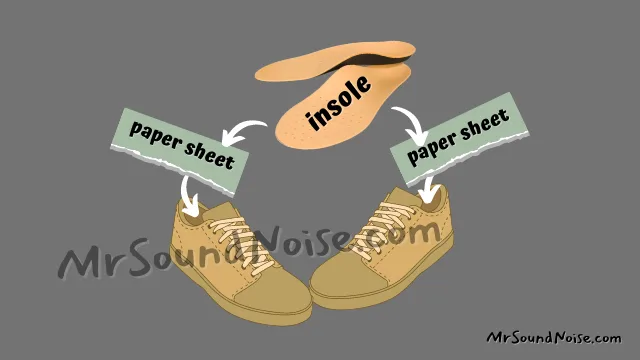
If there is a small gap between insoles and shoes, you may insert a paper sheet under the insole. You may also get a good result after doing it.
First, you should take the measurements of the shoe. Then cut the paper sheet according to that measurement. After cutting these two sheets, dry them so that no water is in these sheets.
After drying, these sheets are ready. Now pull out the two removable insoles from the shoes. Next, insert these two sheets inside the shoes. Finally, again insert the insoles over these sheets.
If you can’t prepare the paper sheets, you can also use dryer sheets, napkins, or other soft sheets. You can change these sheets, after using them for some days.
Be careful, the inserted sheets must not be wet by sweat that may come from the legs. You should not use sweaty boots in any situation.
Three: Apply Baby Powder Under the Insoles
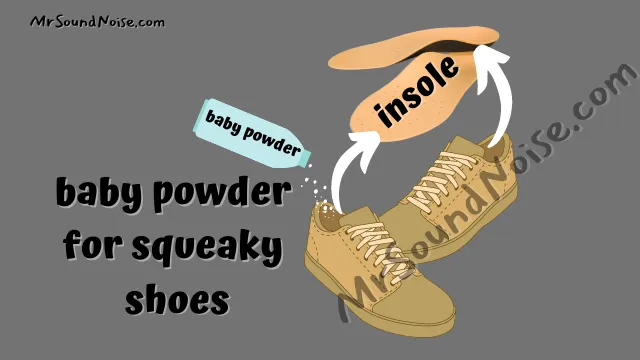
When you are walking, the insoles may move regularly. This may be a reason for creating noise.
In this situation, you should stop this unwanted movement of the insoles. For doing this, first, pull out the two insoles and dry the boots and insoles.
After that collect baby powder for squeaky boots from the market. If you already have this powder, you are welcome. If you don’t have that powder, you don’t need to be sad about that.
You can use dry cornstarch or talcum powder. Now, sprinkle this powder inside the place of insoles slowly.
If the soles are adjusted with shoes and you are not able to pull them out, you will apply powder at the joint or seam side of these insoles.
Four: Apply Coconut Oil or Petroleum Jelly/Lubricant
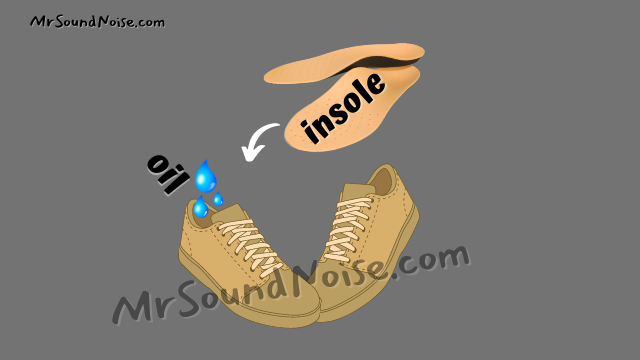
If you still have squeaky noise that comes from your shoes, you can apply this method. Yes, you may use coconut oil, silicone lubricant, petroleum jelly, or waterproof silicone sprays under the insoles.
First, pull out the insoles and apply this oil to the inside of the shoes. You should apply a little amount for creating a thin layer of oil. After that, reinsert the insoles over that oil layer.
This oil reduces the shoe noise that comes from the insoles. You can reapply the oil after using the shoes for a few days. You may try candle wax on the joint of the insole section for reducing shoe noise.
Five: Finish the Bottom Surface (Outer Sole) of the Shoes
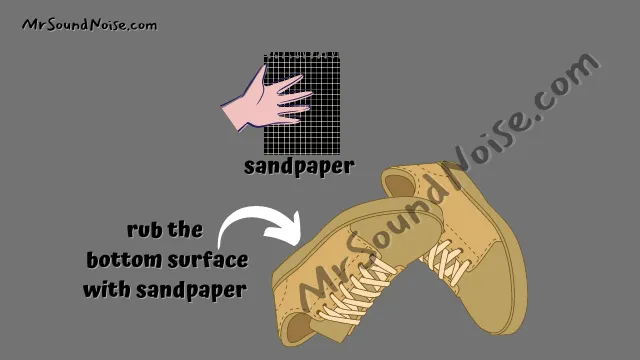
You should also focus on the bottom surface of the pair of shoes/pair of heels/pair of sneakers. When you walk, this uneven surface may create some noise that you can also reduce.
If you see that there is an uneven surface in the bottom part, you need to even or finish that surface. For doing that you should collect sandpaper from the market. After that use warm water for cleaning the bottom dust and dry with a cloth immediately.
N.B: Use the grit sandpaper with 120 grit – 220 grit for fine police (not too much scratch).
This type of sandpaper includes sharp particles with glue. These sharp particles can finish an uneven surface.
Now rub the surface with this sandpaper. After a few times, you will see that the bottom surface of the shoe is not uneven.
Six: Fix the Loose Part with Glue
You should check and find the loose parts. If you see that some loose parts of the bottom side of the shoe and some loose parts around the shoes are available, you should use strong glue (super glue, etc.) to fix those parts (insole and other joints).
If you don’t fix that part, it may create squeaky noise during your walking time. You should wait almost 1 day to dry the applied super glue.
You can use rubber cement adhesive (known as cow glue for the temporary bond) or sticky material for removing the squeaky noise. After applying this glue to the shoe, you can remove it at any time.
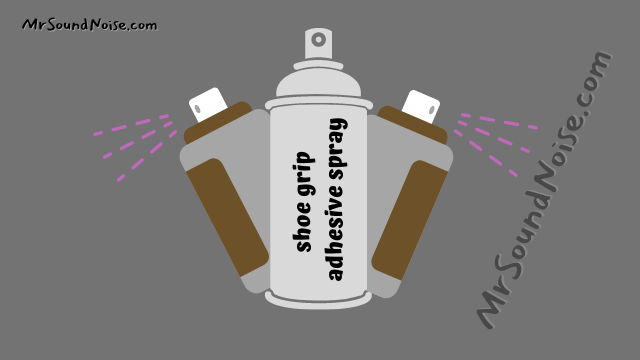
You can use shoe grip adhesive spray on the outer part of the shoe sole for avoiding squeaky noise.
Seven: Apply Saddle Soap to the Shoe Tongue
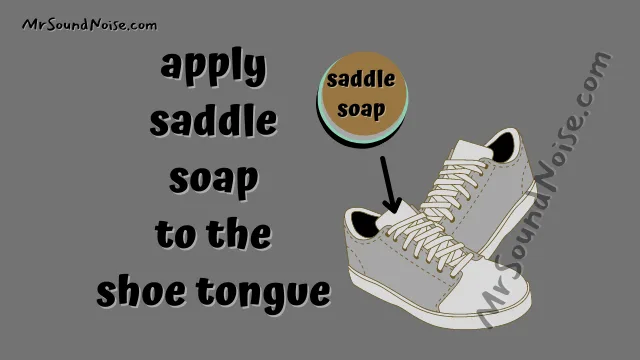
When you see that some sound comes from the laces on tennis or leather shoes and shoe tongues, you should stop that noise immediately.
During your walking time, there may create friction between laces and shoe tongues. For that friction, unwanted noise is created from that shoe tongue.
Now the question is: how to stop that noise?
You may use a bit of saddle soap or leather conditioner in front of the shoe tongue. After using it, you will see that tongue sound will not be created during your walking period.
Eight: Dry Your Leather Shoes
Check if your current patent leather shoes have moisture or not. If you see that there is moisture in your shoe, you need to dry it immediately. Bacteria grows in wet shoes in humidity and creates a bad smell.
Some squeaky sounds may be created by this moisture while walking. You may dry your shoe by using sunlight or a gas burner. That’s your choice.
You can also use a hairdryer or cotton ball or cloth to dry the shoe and it needs lots of time to dry.
Be careful, if you use a burner or fireplace. After drying the shoe, polish and clean visible shoe dust with a shoe brush.
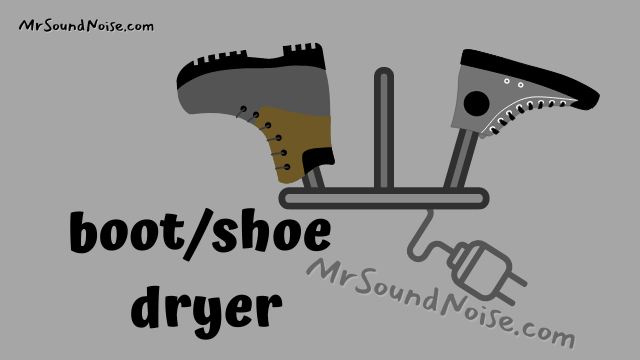
N.B: If you have problems of drying shoes, you can use reliable boot/shoe dryers.
Besides, there is also another option that you may use to reduce moisture. Insert the newspaper, tissue (paper towels), paper napkins, or other soft porous material into the hole of the boots. After some time, you will see that moisture will be absorbed slowly.
Nine: Make a Regular Habit of Wearing Cotton Socks
Your new shoes may wear quickly if you use them with bare legs. A specific type of friction may be created if you use shoes with bare feet.
By using socks, that type of friction is not created in the side of the insole area. So socks may also help you to decrease shoe wear.
You should use a cotton type of sock so that it can absorb moisture instantly from the inside shoe parts. You know that show wear is also a reason for creating sound.
You have also known that moisture is also another reason for creating shoe noise. That is why you should make a habit to use cotton socks if you have no problem.
N.B: Reliable advice from wikiHow (source).
Remember: Check the defects, if you don’t find any noise source. Maximum time, defects are seen in the poor quality boots.
Despite having a good brand, sometimes some boots may have defects during bulk production. If you newly purchase, you should return it as early as possible.
Because brandable companies also have a return facility with funds. Sometimes, brand new shoes make noise for the first time.
If this happens to you, you should wear those shoes inside your room for some time. After doing that, the shoes will become flexible with your legs and don’t create a squeaky sound.
Finally, you can use them outside in public places.
My Overview
Finally, I want to say some basic points that you should read. If you read this total blog writing, you will get specific ideas to reduce squeaky noise from any type of boots.
So the best way is that at first, you should know the information with concentration. Here, I have tried to describe some basic methods in easy ways.
If you follow these methods, I think, you can solve your problem. I have also shared some questions with answers for you. You must read those answers for your easy understanding.
People also wear different types of boots. This is why you should apply the specific method that is related to your current boot. Besides, I have tried to share common tips for reducing any type of boot noise.
It is important to you that you should focus on your boots. Specially. When you are in the office, it represents your personality.
If any type of sound comes from those boots, office workers may laugh with you. So you need to take this issue seriously and take the necessary steps as soon as possible.
If you are a busy person and you don’t have enough time to apply these methods for decreasing squeaky noise, you should fix your boots from a cobbler.
If possible you should wear good brand new quiet heels/shoes instantly. You should also take care of your boot so that moisture can’t be created in it.
You should regularly clean the boots with a cleaner and shoe brush. Try to wear dry socks regularly.
If you accidentally wear wet socks, the insole absorbs that water and creates moisture in the inside portion of the shoe area. So be careful before wearing the socks.
FAQ: Make Your Shoes not Squeak on Hard and Creaky Floors
How to Stop Rubber or Clove Shoes from Squeaking?
Wipe the total rubber sole and insole part so that water may not exist. It will be better if you dry the inner side perfectly.
After doing that you may be able to reduce the squeaking noise from clove shoes. Besides, you should also follow the other methods for reducing some more sound from those rubber shoes.
Why do my Sneakers or Peyton’s Shoes Squeak on the Floor?
The joining part of the sole and insole section is the main reason for creating that noise. When you walk on the hard tile floors, there may be friction between the sole and insole.
If moisture is available in your sneakers or other orthotic-lined shoes, it may create that sound of friction.
How to Repair Squeaky High Heels?
Apply cornstarch/baking powder or baby powder, in the insole section. This will help you to reduce insole moisture. Also, check the air gaps in your high heel shoes.
You may change the bottom heel from the shoe repairer/repair shop if you think that heel creates noise while walking on the office floor.
You should follow the methods that I have already explained in this post. If you don’t understand how to fix it, you should take help from a cobbler.
If the powder doesn’t work, you may try vegetable oil.
Can You Stop the Squeaking Noise from the Boot?
You should use mink oil on the leather parts of that boot so that that leather can be waterproof. You should apply oil to the stitching side of that boot.
Thus moisture will not create in that section and reduce boot noise. Besides, you should also check the insole and sole part and take the necessary steps (explained above).
So you should fix the squeaking shoes/boots that reflect on floor sound effects.
After reading the detailed methods, I think you will be able to find the answer to this question: how to stop or fix the Nike/Ecco/leather shoes or boots from squeaking noise on the hardwood floors?
How Do You Make Your Sandals Stop Squeaking?
To stop that noise, you should dry your sandals in the sunlight for a long time. After removing moisture from those sandals, the maximum squeaking noise will be decreased.
Can You Use a Chemical Solution on the Shoe?
It will be better if you don’t spray any chemical solution. The shoes may be damaged quickly by the chemicals. You should use shoes or boots cleaning solutions that you can collect from the market.
